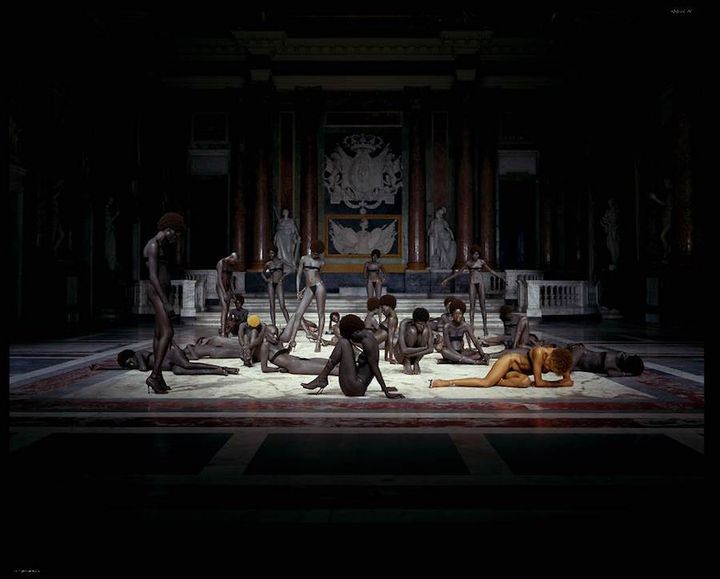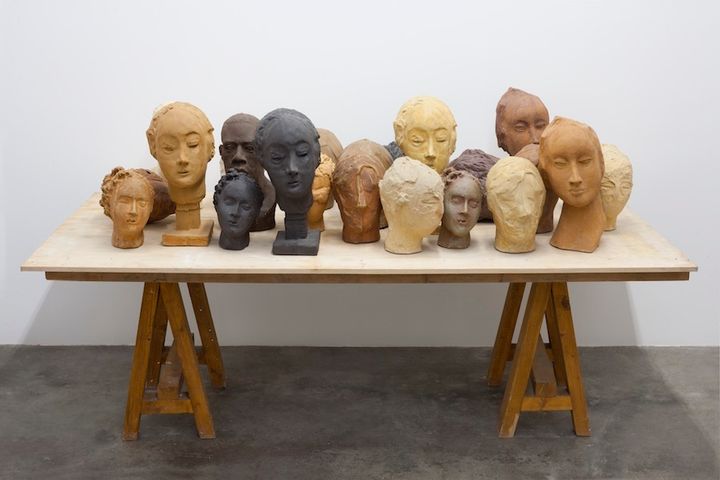
The new space created for large art exhibitions Pio Pico in Los Angeles, founded by Federico Spadoni, opens its doors to the public for the first time and until March, will host an exhibition based on the notions of classical sculpture by the multidisciplinary artist Vanessa Beecroft (Genoa, 1969). She is internationally known for her iconic conceptual performances which often include historical, political or social references associated with the place where they are made. Subsequently filmed and photographed, these solemn groups of hieratic naked or half-naked women coexist in a form of sociable unsociability.
Beecroft suffered from eating disorders since the age of 12. This obsession with food led her to write a diary of all the foods she consumed for ten years: «The Book of food». This diary was the center of her first performance in Milan in 1993 where she made herself known to the world of art. The presentation also included the «living sculptures» of 30 women with eating disorders, wearing their own clothes and moving through the space where the performance took place.
It could look like the other side of the mirror...What is autobiographical about your performances?
The emotional impact, narrative and certain traits of women. The relationship with the public which is confrontational or, as Dave Hickey defines it, there is a separation, a use, in addition to governing rules that do not apply to us.
You said “The day I decided to use The Book of Food as art was the day I stopped”. Does art heal?
Art does not heal. It transforms aspects of life into an iconic and permanent form. It translates pain into something universal that transcends life in its immediacy.

As an Italian, you will have grown up surrounded by the history of art, in a natural way. Which sources provide the artistic inspiration for the aesthetics of your performances and photographs?
In Italy, as a child, culture became a landscape and an immediate background. Instead of a flower you’d see a Laurana head or a Pollaiolo painting. You were raised not seeing the difference between a girl, a Piero della Francesca portrait, and a random religious painting on a fresco on your walk to school. The sources of my inspiration became the paintings and sculptures of the 15th and 17th century, and the architecture of any era.
What type of beauty does your art convey?
A beauty that is equally particular and universal, that tends to be idealized but comes from the street. A beauty connected to the human form, the female form in its artistic, cultural and social representation. I use beauty to relay other hidden messages.

That mystery makes your work open to different interpretations which creates a lot of controversy. How do you perceive the women you represent? Why collective and not individual?
The women are often there as a physical equivalent of what I am going through. She is not alone because she is speaking for a group, for more than one person and because a group is stronger and more convincing than an individual. The women have similar aspects but there are also differences between them. They are organized in a hierarchical formation in which there are privileges and unbalance, symmetries and color-schemes.
You have been defined as a feminist. What does feminism mean to you?
The fight of women to survive in a society built by men, mostly white men. Feminism today cannot be the same as it was in the past. The new feminism is stronger because women accept their womanhood, their body and their maternal power, while before they were forced to deny their identity as a female since it tied them to so many bad memories.

You have collaborated with the rapper and designer Kanye West over ten times. Your presentation of his new clothing line Yeezy Season 3 and his album The Life of Pablo in Madison Square Garden became the most-viewed performance art in history, with over 20 million viewers. How has this collaboration influenced you?
We dealt with a larger audience than the one of the art world and a general audience that had to perceive a message in a more direct way. The social impact was greater and the artistic value could be less subtle. Kanye’s work intended to go beyond its artistic value, to the point it affected his own life. I was influenced on a human level and after the experience, I longed to be in the artist’s studio.
What is it about your relationship with Africans that makes you feel autobiographical when you work together?
I only work on matters I can identify with.
Your iconographic framework has always involved the human figure, almost exclusively the female one. What is the meaning of the body as an instrument in your art?
It’s the most direct way of talking about humankind, in this instance of a woman, my own experience, and a shortcut to use forms, lines and colors on the subject closer to me: myself. However, I do not consider the body to be something physical. The body is there to express intellectual thoughts, emotions and formal solutions.

Your new sculptural work, for Pio Pico’s inaugural exhibition in Los Angeles, is inspired by notions of classical sculpture. What can you tell us about this series?
The sculptures have been molded by hand in clay, from the source material I could find in LA. I molded them without a plan just as when I sketch. Then they were fired in various colors’ clay. Some survived the kiln, but many didn’t. I assembled them in a performance-like group using materials like wood and beeswax as support and as a way to add a bit of coloring. There is also a large mural which represents the body imprint of a group of women, mostly African-American. The imprint was made on clay and a positive in plaster is exhibited. I wanted to realize a negative in ceramic but it was too difficult to achieve an optimal result for this exhibition.
There are also bodies…
Yes, classically inspired large sculptures of clay. One of them has exploded tonight. The other one is put together roughly by beams of wood. I don’t think of sculpture as a category. I think of all disciplines as a way to relay my story.

